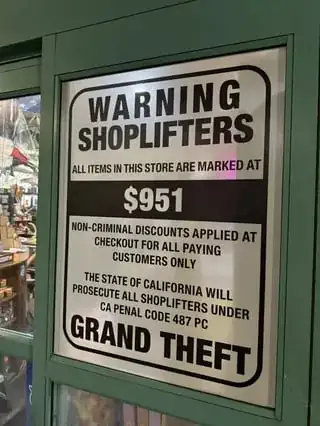canada
This sign would likely be ineffective at altering the charge or sentence.
Theft is defined in the Criminal Code at s. 322 and the offence is created at s. 334. The severity of the offence turns on whether the "value" of what is stolen is more than $5,000.
To prove theft over $5,000, the burden is on the Crown to prove the higher value beyond a reasonable doubt.
In the retail shoplifting context, courts have looked to what price the thing would typically sell at. See R. v. Wheeler, 2012 ABPC 127, para. 36 (relying on reasoning from the BC Court of Appeal):
In the context of the criminal law, as it relates to the theft of property, it would seem most appropriate that the value is determined by the monetary worth of the property to the owner. In the context of a retail operation, this value would be the retail price, as the value is the price that a seller is willing to accept and a buyer is willing to pay on the open market in an arms length transaction.
In the scenario you describe, the Crown would have difficulty proving beyond a reasonable doubt that people were actually willing to pay $951 for the items.
Low-level shoplifting is "not considered a very serious offence" (R. v. Hackett, 2013 CanLII 80918 (NL PC), para. 24):
the usual range of sentence for shoplifting type theft offences includes discharges for first time offenders, fines, suspended sentences with probation (with a condition prohibiting the return of the offender to the premises where the theft was committed for a few months), or short and sharp periods of imprisonment where there is a prior related criminal record.
A store owner is not able to dictate a different approach by the use of signage.
Last, charge approval is an individualized exercise. The claim that "all shoplifters" will be prosecuted, whether under a given provision, or at all, would not reflect Crown charging policy.
